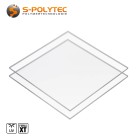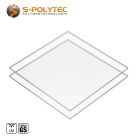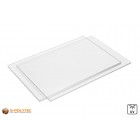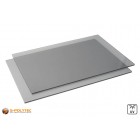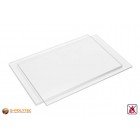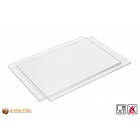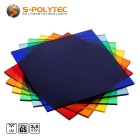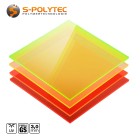
Buy transparent plastic sheets cheaply cut to size
Transparent plastic panels are not only used as a substitute for glass. However, not all plastics are the same, so we have summarised all the transparent plastics in our online shop here for you.
- We have the right panel in transparent design for every area of application
- We always have extensive stocks of transparent plastic sheets in all thicknesses
- Short delivery times are possible thanks to optimised production processes
Transparent acrylic glass XT cut to size | S-Polytec
 from €18.75 / m2
from €18.75 / m2Incl. 19% Tax
Transparent acrylic glass GS cut to size (colourless)
 from €28.87 / m2
from €28.87 / m2Incl. 19% Tax
Polycarbonate sheets transparent custom cut (UV-stabilised)
 from €39.09 / m2
from €39.09 / m2Incl. 19% Tax
Polycarbonate sheets grey custom cut (UV-stabilised)
 from €52.19 / m2
from €52.19 / m2Incl. 19% Tax
Hard-PVC sheets transparent 2x1 meter
 from €26.78 / pcs
from €26.78 / pcsIncl. 19% Tax
PETG Sheets transparent 2x1 meter
 from €21.11 / pcs
from €21.11 / pcsIncl. 19% Tax
Coloured acrylic glass GS cut to size (transparent)
 from €48.08 / m2
from €48.08 / m2Incl. 19% Tax
Fluorescent acrylic GS cut to size (transparent)
 from €49.67 / m2
from €49.67 / m2Incl. 19% Tax
Transparent plastics sheets
Transparent panels made to measure? We do it!
The areas of application for transparent plastic sheets are extremely diverse. In the rarest of cases, however, they are required in the standard format of 3050 x 2050mm and still have to be cut to the required size. We at S-Polytec not only have an extensive selection of transparent plastics in many thicknesses, colours and designs, but also the necessary know-how and machinery to cut your transparent sheets to exactly the size you require. Thanks to extensive storage at our two production sites, short delivery times are also possible for larger orders or extensive cutting to size.
Our standard delivery programme for transparent plastic sheets
- transparent acrylic glass (PMMA) cut to size up to 2000x1000mm
- Transparent polycarbonate (PC) cut to size up to 2000x1000mm
- Transparent rigid PVC (PVC glass, PVC-U) in standard format 2000x1000mm
- Transparent polyethylene terephthalate glycol (PETG) in standard format 2000x1000mm
Our extended delivery programme on request
- Transparent acrylic glass cut to size or as standard sheet up to 3050 x 2050mm
- Transparent polycarbonate cut to size or as standard panel up to 3050 x 2050mm
- Transparent, tinted acrylic glass in various colours laser-cut
- and many more
Note: Please note that delivery times and shipping costs may vary for our extended delivery programme. Our friendly advisory staff will be pleased to inform you about our transparent plastic sheets at any time.
Typical example for transparent plastic sheets
For all applications where glass is used, there is also a corresponding alternative made of plastic. The use of transparent plastic sheets is usually not only more cost-effective, but is also much easier to process than glass, because the further processing of plastics can be done with simple tools. For cutting to size, standard commercial woodworking machines are sufficient. In addition, transparent plastics can be brought into almost any shape by thermal deformation, which is retained after cooling. In contrast to glass, relatively low temperatures are required for thermoforming, depending on the selected plastic.
- Terrace canopies made of impact-resistant polycarbonate save weight compared to panels made of real glass
- shelves in cupboards and showcases can be made of scratch-resistant acrylic glass
- Food-grade PETG is most suitable for viewing panels in refrigerated counters and refrigerators
- Flame-retardant PVC is recommended as a substitute for glass in public interiors
- For viewing windows in machine construction, the break-resistant polycarbonate is a safe alternative to glass
- Acrylic glass is the most suitable material for the construction of aquariums or terrariums made of plastic
When choosing the right plastic, it is important to remember that it must be suitable for the intended use. The plastic glazing of a refrigerated counter for sausage and cheese, for example, must be food-compatible and suitable for temperatures in the minus range. However, UV and weathering resistance is not usually necessary here. For terrace roofs, however, weather resistance is a minimum requirement, as is frost resistance. However, a terrace roof does not have to be suitable for use with foodstuffs.
Characteristics of transparent plastic sheets
There are various types of plastic in transparent versions, each with different properties. However, they all have one characteristic in common. This is the high light transmission, which, however, is limited in coloured plastics with transparency due to the addition of colour pigments.
Which plastic is suitable for the desired area of application is therefore always dependent on the specific application.
Scratch-resistant plastic plates in transparent
Transparent plastic sheets with a scratch-resistant surface include acrylic glass sheets. Acrylic glass owes this to its comparatively high surface hardness, but for the same reason it is not as impact-resistant, which is why the sheets can break more quickly than polycarbonate or PETG.
Impact resistant plastic sheets in transparent
Polycarbonate is one of the most impact-resistant plastics in transparent design. This plastic, which we offer in clear, transparent as well as grey tinted versions, is also known by the brand names Makrolon® or Lexan® among others. Polycarbonate is considered to be extremely impact resistant and break-proof, but has the disadvantage that the surface hardness is comparatively low and therefore does not match the scratch resistance of acrylic glass.
PETG sheets are also among the most impact-resistant and break-proof plastic sheets, with excellent transparency. However, the impact strength of PETG is lower than that of polycarbonate. PETG is considered to be flame retardant and is food safe.
Weatherproof plastic panels in transparent
UV and weathering resistance is an essential property when it comes to the use of plastics in outdoor applications. Both our acrylic glass sheets and our polycarbonate sheets can be used outdoors without hesitation because both plastics are UV-stable and weatherproof. For this reason, these plastics are also frequently used as glass replacements for terrace roofs, weight-reduced plastic glazing or greenhouses.
Rigid PVC in transparent design and PETG are not UV-resistant and therefore not directly suitable for outdoor use. UV radiation could cause the plastic to become brittle in the long term. In addition, the high transparency of these sheets will be reduced over time, which may result in the sheets becoming cloudy. However, both plastics are also available as UV-stabilised versions on request.
Flame resistant plastic sheets in transparent
Transparent plastic sheets can also be used for applications where flame retardancy is required. These plastics include transparent sheets made of rigid PVC, which are often referred to as PVC glass. PETG is another transparent plastic in a non-flammable version according to the fire protection standard DIN 4102 B1.
Acrylic glass and polycarbonate on the other hand - like most plastics - are considered to be normally flammable.
Food-safe plastic sheets in transparent
There are some plastic sheets with food approval. For example polyethylene, polypropylene or PTFE, which is known to most people under the brand name Teflon®. These plastics are all not transparent. Acrylic glass, polycarbonate or PVC, on the other hand, are available as transparent sheets, but are not food-compliant - i.e. not approved for contact with food.
The plastic that can have both properties is polyethylene terephthalate glycol - PETG for short. PETG is a highly transparent polyester, which is considered physiologically harmless according to BfR and is classified as food compliant according to FDA / EU10/2011.
Temperature application ranges of transparent plastic sheets
Not all plastics can tolerate both high and low temperatures. Transparent PVC with a temperature range of 0°C to +60°C is neither frost-resistant nor can it be used permanently at higher temperatures. PETG also does not tolerate high temperatures, but can be used even at sub-zero temperatures. With a temperature application range of -40°C to +120°C, polycarbonate covers the largest range and is therefore both frost and heat resistant.
